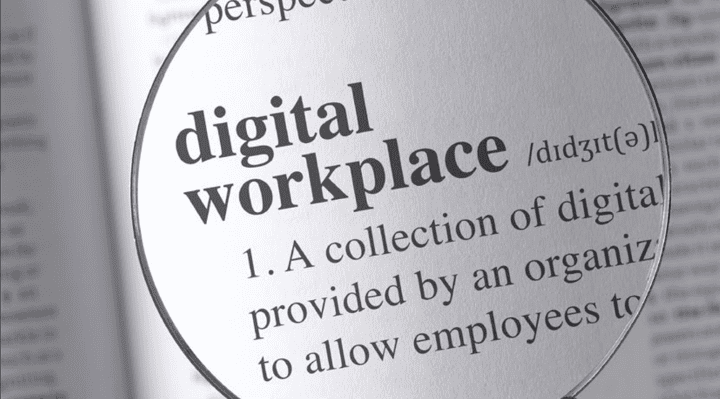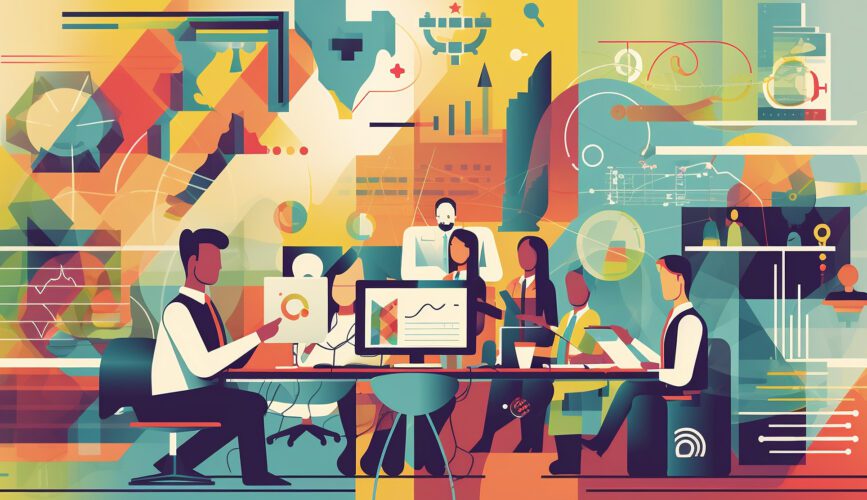Digital workplace, digital employee experience, intranet; what’s the difference?

You are about to launch an intranet, but it goes beyond what a ‘traditional’ intranet typically is, offering integrations with a number of other apps. Perhaps this is a digital workplace then? But it is also focused on improving the overall experience of employees; so, is this in fact a digital employee experience platform? And, if so, how should it be positioned to employees? And does this actually matter?
One of the more confusing aspects of the intranet and digital workplace space these days is how to define the channels and environments we launch. Different terminology can be applied that has considerable overlap and is even used interchangeably – and there isn’t always a consensus on the exact definition. This is particularly pertinent to the term ‘intranet’, a label that can conjure up negative reactions from people who have experienced poor intranets in the past.
In this post we’re going to unpack the terms ‘digital workplace’, ‘digital employee experience’ and ‘intranet’ in an attempt to establish some clarity around what they actually mean and the differences between them.
Things to remember about digital workplace terminology
There are several things worth remembering about terminology in this space:
- There is pretty much a consensus about the general meaning of all three terms, but no agreement on an exact definition.
- Definitions change over time as trends evolve – for example, the features that might have been considered within scope for an intranet in 2003 have expanded considerably in 2022.
- Some terms do come with baggage – as already noted, the intranet comes with some (unfair) perceptions of being an out-of-date and ineffective channel.
- Vendors use terminology to describe their products, which tends to muddy the waters – intranet software might now be marketed as an employee experience platform, for example.
- The terms are used differently from organization to organization, and sometimes other terms, such as ‘people experience’ or ‘portal’, are also used.
- Some organizations use either a product name (e.g. SharePoint) or a brand name (e.g. ‘The Hub’) to describe their intranet or digital workplace environment.
Of course, one overarching question is whether this really matters. The answer is probably both yes and no; we’ll return to this theme at the end of the article.
What is an intranet?
Intranets have been around since the mid-nineties in one form or another, and are still very much part of the workplace technology landscape. Most organizations have an intranet of some kind and choose to invest significantly in them. Occasionally we hear observers declare that “intranets are dead”, which is simply not true; dig a bit deeper and what they are actually saying is that “intranets have evolved” and it’s just the traditional, content-heavy (and largely unsuccessful) intranets that are “dead”.
When intranets were first launched, they were typically defined as an internal, restricted website that was only available behind a firewall and generally targeted to employees, in contrast to the public internet; or as an extranet that was available externally but with restricted access only. While the cloud now means that many intranets could be defined as an extranet, generally an intranet is still a restricted site aimed at employees.
Classically, intranets have always been browser-based and centred around providing access to content that helps employees to stay informed and get things done. Most intranets still have this at their core, enabling content publishing that can be viewed through the browser. However, where intranets have evolved over the years is in absorbing many extra features and a great deal of functionality; in fact, the ability for intranets to expand their remit and scope is one of the reasons they are still around today.
Wave after wave of features, such as discussion forums and communities, project-based collaboration, social networking, video, mobile support, integrations with other corporate systems, transactional abilities, forms and workflow, have all been absorbed into the intranet. In particular, social networks like Jive and Yammer were meant to kill off the intranet – which, of course, never happened. Instead, many organizations are now retiring Jive to introduce an intranet, or actively integrating Yammer into their SharePoint intranet.
This expanded scope of the intranet has led people to ask: “Is an intranet still an intranet?”. With the number of possible integrations from different applications and platforms, it can be difficult to define where the intranet and a separate application starts and ends; is that Yammer feed embedded within an intranet page part of the intranet or just Yammer? The role of the intranet as the single entry-point into numerous applications means it is also effectively a ‘front door’ into the wider digital workplace; does this therefore mean that the intranet is in fact a digital workplace?
DWG’s view is that the intranet remains a distinct and important channel within the wider digital workplace – more explanation of this below! We also tend to use the label ‘modern intranet’ to describe an intranet with integrations and expanded features, differentiating it from the content repositories of the past.
What is the digital workplace?
Paul Miller, DWG’s CEO and Founder, was an early pioneer of using the term ‘digital workplace’, along with others such as Jane McConnell. By 2009, DWG was using the term frequently to describe the wider ecosystem of platforms and applications that were increasingly becoming the responsibility of the intranet team, or being integrated into the intranet. It was also the title of the book Paul published in 2012. As the digital workplace become more the focus for our benchmarking, research and member forums, we eventually rebranded from the Intranet Benchmarking Forum to Digital Workplace Group (DWG) in 2014.
The term digital workplace is still actively used in the industry today, including by leading IT analysts like Gartner. It can generally be defined as the wider set of applications, digital tools and channels that are provided for employees to carry out their work. But there is no consensus on its exact meaning; in 2015, Ephraim Freed wrote a post for this blog which explored eight definitions of the digital workplace!
One approach highlighted in Ephraim’s post is the definition we still broadly follow today and was the basis for our digital workplace maturity benchmark:
“the collection of all the digital tools provided by an organization to allow its employees to do their jobs.”
This definition means that actually every organization has a digital workplace, and it also suggests there is a clear distinction between the digital workplace and the intranet, which remains a critical channel within the wider digital workplace, acting as a convenient entry-point, front door or that ‘single pane of glass’. But it is worth noting that any single environment such as an intranet which provides that convenient launchpad or aggregated view of the wider set of applications in use by employees is, in our view, not the digital workplace itself.
What is digital employee experience?
Employee experience is a term that has been growing in use by HR professionals for some time and has now been embraced by the digital workplace industry, including vendors, analysts, consultants and practitioners. Employee experience refers to the overall experience of people who work for a company, covering all touchpoints including multiple elements such as:
- pay and benefits
- opportunities to work flexibly
- the sense of community and connection employees feel
- quality of the physical workplace
- the onboarding experience
- the digital workplace employees use every day
- and more!
This may seem a wide definition, but it encourages employers to think holistically and in more joined-up ways about the overall employee experience, and to regard this as a strategic factor that can positively impact everything from employee attraction and retention through to productivity and customer service.
Employee experience is also a term that’s been embraced by intranet and digital workplace vendors who are keen to position their software as an employee experience platform (EXP); whether an application described as an EXP is actually just delivering a humble intranet probably depends on your point of view.
In terms of our definitions, digital employee experience could be considered to be the way in which employees experience the digital touchpoints with their employer. James Robertson explores this theme by defining digital employee experience as “the sum total of the digital interactions within the work environment” and goes on to focus on two lenses for understanding it – the employee lifecycle from the point when a person joins a company to when they leave, and then the digital workplace itself. The employee lifecycle is often focused upon by HR functions and also the digital workplace teams who design channels, environments and applications that serve all the important ‘moments that matter’ during that lifecycle, such as, for example, employee onboarding.
Digital employee experience is therefore quite distinct from a digital workplace or intranet in that it is not actually a channel or environment. A good intranet and digital workplace should deliver a good digital employee experience, but it is not the same thing.
Do definitions really matter?
A key question in all this is whether the terminology really matters. To a certain extent, it doesn’t, as users just want to get the content, information and apps they need in order to get things done. They don’t really care about the semantic details behind where your intranet stops and the rest of the digital workplace starts.
However, behind the scenes, successful intranets and digital workplaces that deliver a good digital employee experience require consensus and effective cooperation between different stakeholders across your business who need to work together. There can be strong opinions – sometimes negative or misinformed – about what intranets can do. ‘Employee experience’ can be a powerful term and concept that resonates with senior stakeholders and is a current priority for HR functions. Meanwhile, the IT function might be thinking more about the ‘digital workplace’ and the scope of what that is, for example, how best to use the Microsoft 365 platform. Software vendors are actively using all these terms too, so understanding exactly what they are offering is also key.
Defining all these terms and making sure everybody understands what they mean can help to:
- ensure that everyone is working from the same page and is aligned on strategy and scope
- argue a business case for investment
- position the environment to employees.
Clarity is important – and often this starts with clear definitions of terminology. Even if you don’t agree with our own definitions of ‘intranet’, ‘digital workplace’ and ‘digital employee experience’, do make sure that they are clear to you and consistently used across your organization.
Categorised in: Digital employee experience, Digital workplace, Intranets


